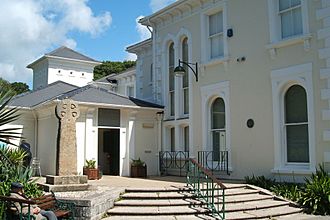Penlee House facts for kids
Quick facts for kids Penlee House Gallery and Museum |
|
|---|---|

Penlee House & Cross
|
|
| General information | |
| Location | Penzance, Cornwall, England |
| Coordinates | 50°6′59″N 5°32′28″W / 50.11639°N 5.54111°W |
Penlee House is a cool place in Penzance, Cornwall. It's both a museum and an art gallery! You can see lots of amazing paintings here, especially ones by artists from the famous Newlyn School. Some of the famous paintings include The Rain It Raineth Every Day by Norman Garstin and School is Out by Elizabeth Forbes. The local Penzance Town Council helps run Penlee House.
Contents
Discovering Penlee House
Penlee House was first built in 1865. It was the home of a rich family called the Branwells. John Richards Branwell had it built, and people said the house and gardens were "delightful."
After John Richards Branwell passed away in 1902, his daughter Edith took care of the house. Later, it went to her brother Alfred. After Alfred died in 1939, his daughters sold the house and its land to the Penzance Borough Council in 1946.
The council bought the land, now called Penlee Park, as a special memorial for those who died in World War II. Penlee House officially opened as the Penzance District Museum in 1949. Today, the Penzance Town Council owns and runs the museum and park.
The Museum's Journey
The museum's collections came from an older group called the Penzance Natural History and Antiquarian Society. This group started in 1839. Their first museum was in the dome of the Market House in Penzance. It had all sorts of things, like animal skins, skeletons, and old artifacts.
In 1867, the museum moved to a bigger building called St John’s Hall. Over time, the original society stopped working. Many items were sold or damaged, and some even went missing! For example, a gold bracelet from the Bronze Age disappeared.
After World War II, the Penlee Estate was going to be sold and the house torn down. But the Mayor, Robert Thomas, asked the public to help buy it. They raised £13,000 to save the estate as a War Memorial. They decided to use the house as a museum and art center.
The museum opened in its new home at Penlee House on June 24, 1949. In the 1990s, Penlee House got a big makeover. They added new gallery spaces, a lift, a cafe, and a shop. They made sure to keep the old-fashioned feel of the Victorian home while making it modern for the art and collections.
The museum's collections cover 6,000 years of history in West Cornwall. You can see amazing things from ancient archaeological sites and learn about the area's more recent social history. The galleries show how people have lived and worked in West Cornwall for thousands of years. You can find Bronze Age jewelry, 1930s fashion, and other cool historical items.
Building Penlee House
In 1860, J. R. Branwell started buying land on the edge of Penzance. He wanted to build his new home and a large park around it. During a renovation in 1997, workers found a stair step with nails marked "1864." This shows the house was being built that year.
The park around Penlee House had both fancy and natural gardens. A small lodge was built at one end of the park. When the house was first built, there was no Morrab Road. Penlee House was right next to the Morrab House Estate, which is now the Morrab Library and Morrab Gardens.
Penlee House originally had many rooms. There were three main living rooms, a dining room, and a drawing room. It also had a kitchen, a butler's pantry, and an office. Upstairs, there were three main bedrooms, including separate ones for J.R. Branwell and his wife. There were also smaller bedrooms for family or servants.
In 1946, people helped buy the estate to be a War Memorial. It would also hold the town's history and art collections. The house opened as the District Museum in 1949. Even with all the updates, they have tried to keep the feeling of a grand Victorian home.
The Ancient Cross
Outside the museum, there is a large granite cross. It is very old, from the 11th century! This cross has been moved at least three times. Its first home was in the Green Market in Penzance. It was used to mark the official boundary of Penzance.
In 1829, it moved to North Street. Then, around 1868, it moved again to the western end of the Market House. In 1899, it was moved to Morrab Gardens. Finally, in 1953, it came to Penlee Park. On September 23, 1997, the cross was placed in its current spot by the new entrance to Penlee House. You can see all four sides of this ancient cross. It is about 2.07 meters (nearly 7 feet) tall.
Newlyn School Art
Penlee House is famous for its many paintings by artists from the Newlyn School. The beautiful scenery of Cornwall has attracted artists since the early 1800s. In the 1880s, many British painters came to Newlyn. Many of them had studied art in Paris or Antwerp.
Newlyn was a great place for artists because it showed scenes of life that hadn't changed much due to the Industrial Revolution. There was also cheap housing and people who were happy to be models for the artists. Soon, many artists settled there, forming the group known as the Newlyn School.
Images for kids
-
The painting was sent to the Royal Academy in 1889 but was not hung. It is believed that the committee thought the painting too 'French' in style. When the painting first came into the possession of Penzance Town Council, it was not displayed as it was decided that tourists would be put off by the depiction of Penzance in the rain. Nowadays, it is one of the most popular works in the collection.






